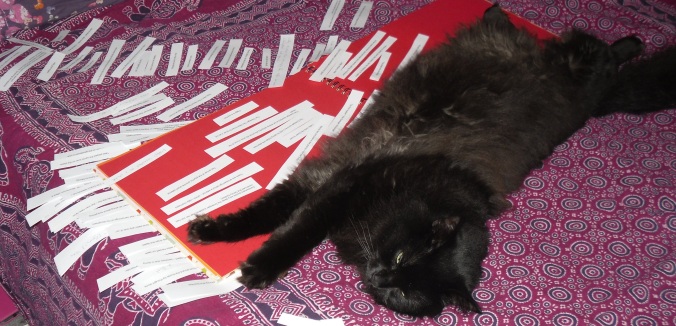First draft dialogue, eh? Isn’t it marvellous.
According to a bloody good documentary I saw a while ago, ‘er Royal Highness Hilary Mantel begins with dialogue. (I believe, in said documentary, she claimed she could make dialogue out of the telephone directory.) (And I, for one, believe her.)

First draft of Wolf Hall.
What makes good dialogue?
I can tell you what doesn’t make good dialogue: the bobbins I wrote this morning. But it’s NaNo, right? It’s just about getting the words down and shaping the scene. And that’s fine.
Just so long as no-one (NO-ONE) ever reads it. Until it’s been put through the Subtlety-Wringer and exorcised of its hideous melodrama.
Most first-draft dialogue (unless you’re extremely good at it) tends towards the melodramatic. People speak their thoughts. They actually answer each other’s questions, as if life was just one big interview session, and tell each other all sorts of things that an actual human being would never reveal without thumbscrews, or a box full of rats, or a hot poker to one’s rectal cavity.
I like writing dialogue, but it isn’t my forte. To be honest, I used to suck harder at dialogue than Linda Lovelace in Deep Throat. It took a long time to get better at it: for a long time I thought ‘getting better at dialogue’ meant rearranging the words somehow (and it partly does mean that; all writing means rearranging the words somehow). It was reading Story by Robert McKee that really woke me up to the flaws in my dialogue. I’d been writing, and rewriting, the same short story – on and off – for fifteen years (this is honestly true) and the bit I was stuck on was a monologue, delivered by a naked nineteen year old boy. It was a Big Moment. It needed to lead to an Even Bigger Moment. I arranged and rearranged those words more times than an obsessive compulsive word-rearranger. But nothing was working. It never rang true.
And the reason it never rang true? I was force feeding him. Like Vincent Price taking gastronomic revenge on a critic in Theatre of Blood (once seen, never forgotten).

More poodle, Sir?
Good dialogue, as McKee says, comes from knowing your characters. In the case of my unfinished story, the naked nineteen year old’s dialogue never rang true because neither did he. He was only a stooge, shoe-horned into the story to do what I wanted him to. (NB if you’ve just tuned in, I’m talking about a fictional character: I’ve never done anything to a naked nineteen year old with a shoehorn.) So I had to go back to the drawing board, and re-draw him. He still isn’t right, and I’m still not happy, but neither am I wasting time on dialogue that’s never going to work. I’ll come back to him one day, when the novel’s done, and finish him off. He’s been standing beside some brown curtains in only his birthday suit for a very long time now, watching the rain, and I do feel I owe him a climax, eventually. One day. (I repeat: this is a fictional character. I do not keep naked boys next to my curtains.) (And, besides, they’re red, not brown.) (The curtains, that is.)
Crap dialogue, though, is the lifeblood of NaNoWriMo. (Ah, go on, you know it’s true.) When you’re strolling along in your own time, 500 words a day for instance, you’re stopping and noticing what’s going on in the scene you’re writing. You know what everyone’s wearing, what the weather’s like, what sort of chairs they’re sitting in. You dot the Is and cross the Ts.
When you’re knee deep in NaNo and 4000 words in the red, there’s a natural tendency to resort to dialogue. Slowly the rest of the scene decays, like Joel’s memories in Eternal Sunshine of the Spotless Mind and you’re left with disembodied voices. Like an episode of the Archers, without any sound effects. (Did you know they use yoghurt pots to make the squelchy lamb noises? And, ahem, this 2013 Storify of the Archers’ twitter Q & A includes a question from… well, yours truly.)

I’m not saying there’s anything wrong with this. What’s good enough for Her Maj, HM, is good enough for me. Dialogue is a great way of sketching a scene. Just so long as you know that it’s only a sketch, and the colours and textures will have to be painted in later.
As for my word-count, it’s 27,758. Today we’re halfway through. Thanks to yesterday’s slightly bonkers 3798 words, I’m ahead of the game – in spite of a paltry 102 words (of shit dialogue) this morning. I keep having ideas for What Happens Next, and they all seem to function in harmony with each other = A Good Sign, no? I’m also projecting forwards, beyond this draft, to the moment I have to go back and change bits that don’t work. But, hey. That’s what writing is.
I’m off to eat my half-time oranges. Good luck with part 2, everyone!







